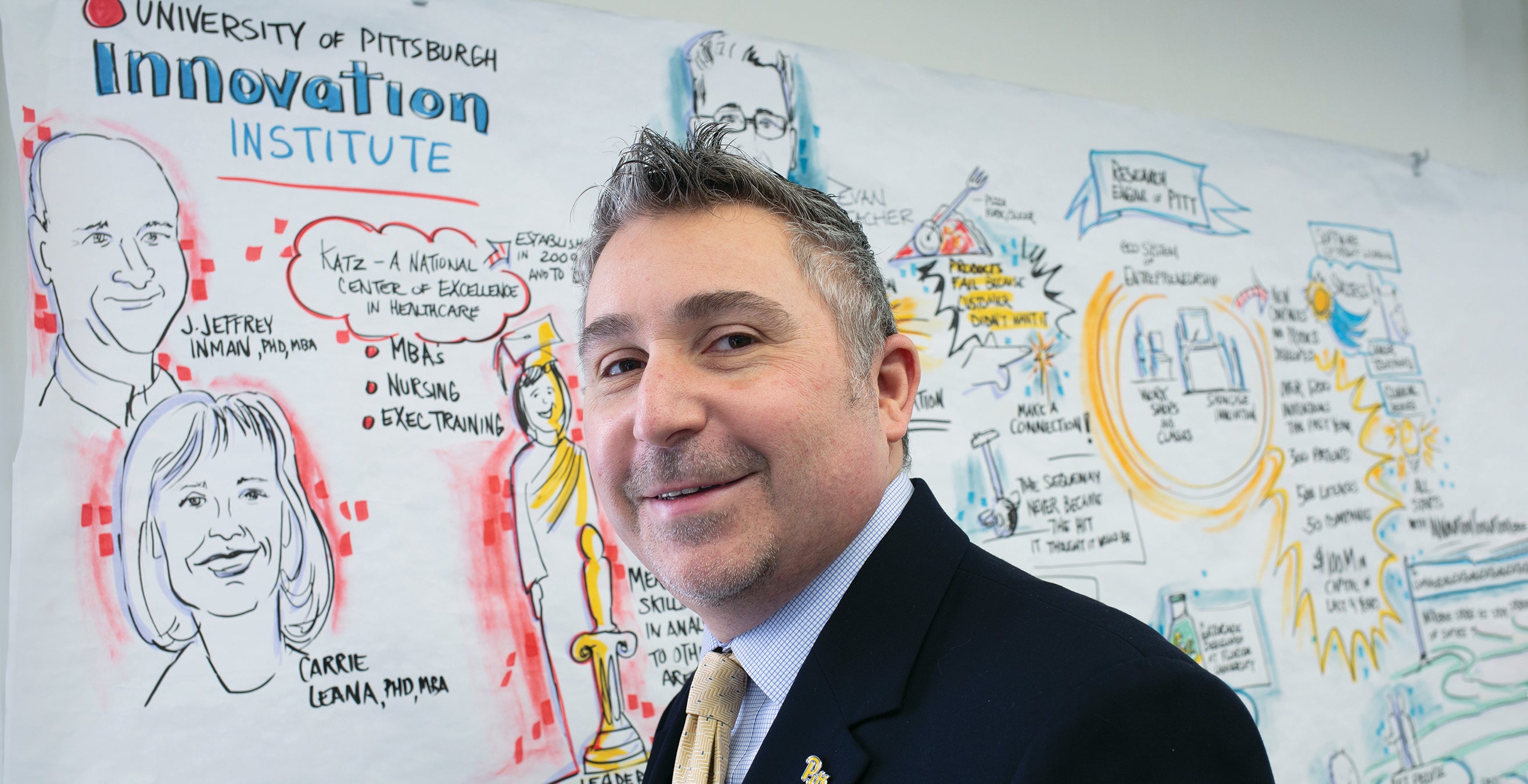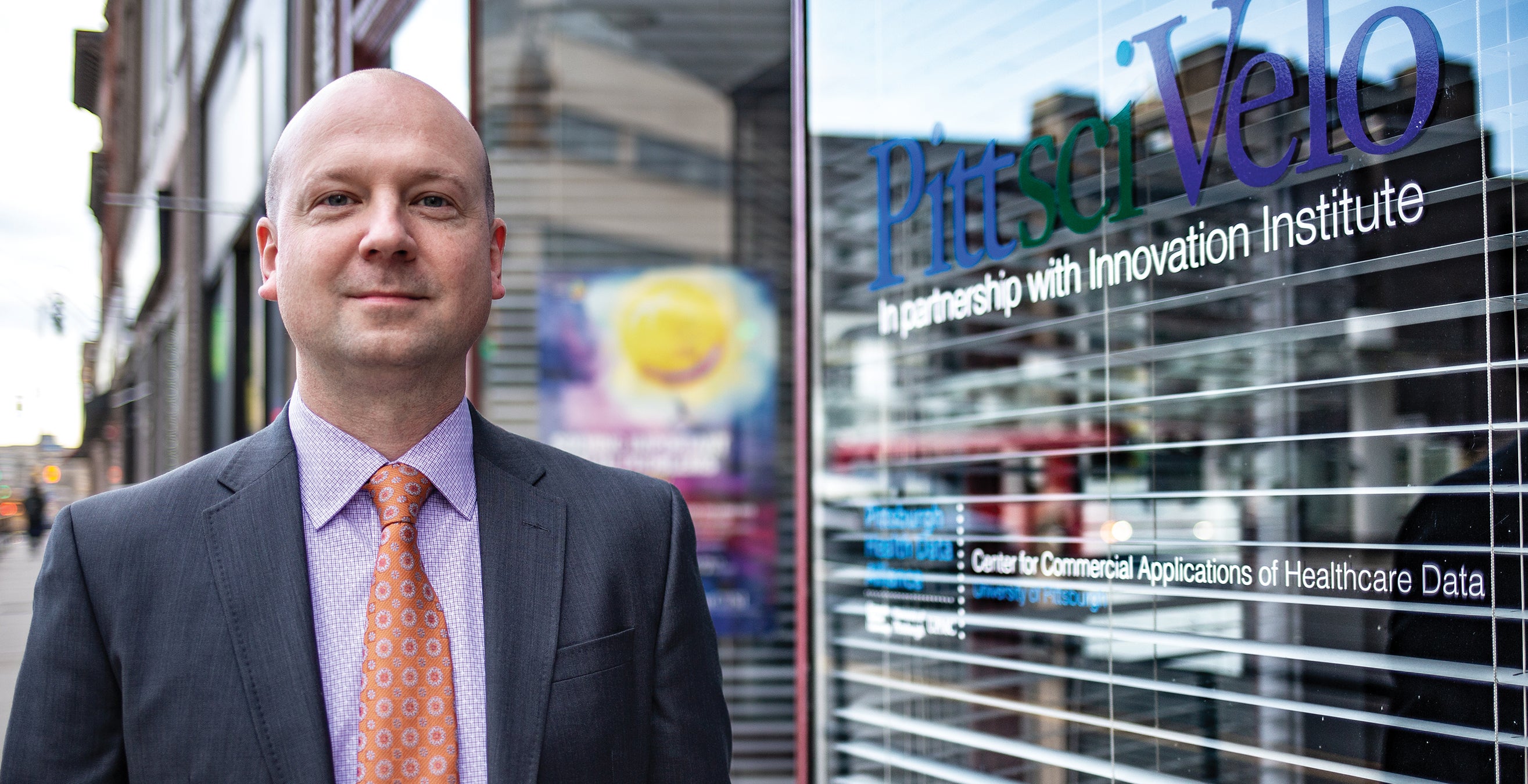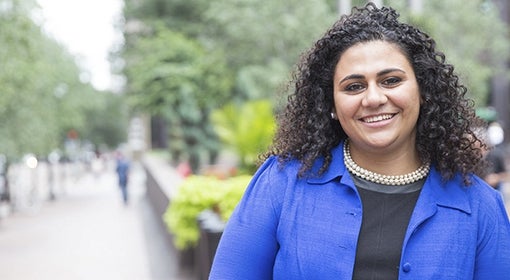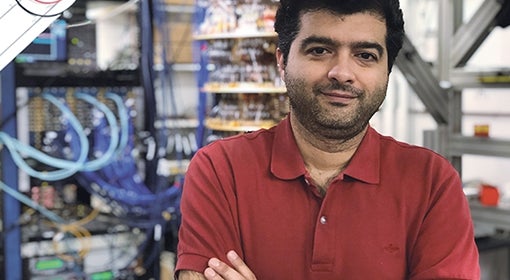If Evan Facher ever wants to make a career switch, he could always audition to become a judge on Shark Tank. The popular television program gives budding entrepreneurs the chance to make a sales pitch of their startup or idea to the billionaire Shark Tank judges, who can provide funding and mentorship.
Providing funding opportunities and mentorship for the University community is much of what Facher oversees as director of the Innovation Institute, which is Pitt’s hub for innovation and entrepreneurship. The institute, established in 2013, is tasked with growing the University’s entrepreneurial ecosystem. To do so, it has evolved from a basic tech-transfer office to a thriving, multidimensional support system for University innovation. The results are encouraging. In the last fiscal year alone, Pitt faculty, students, and staff set records for invention disclosures submitted (363), license and option agreements executed (162), and startup companies formed based on University technology (23).
Rather than audition for Shark Tank, Facher is intent on keeping the institute’s momentum moving forward. “We continue to bring in people who have been involved in commercialization out in the real world, or have marketed products, or have run sales organizations,” says Facher, who is vice chancellor for innovation and entrepreneurship. “We want people who have this expertise and knowledge.” Before arriving at Pitt, he, too, worked in a variety of such settings from big pharma to small startup ventures.
Facher explains what is behind the institute’s success. It is experience: “If you’ve never taken a drug from idea to clinical studies, it’s hard to do it for the first time. If you’ve never received a 510(k) clearance for a medical device, it’s hard to describe how to do it on your own. Having had those experiences, having raised venture-capital dollars, having acquired public companies, these experiences give you a different frame of reference than an academic setting.”
The range of the institute’s programming and services extends from processing invention disclosures, patenting, and licensing of intellectual property; to training programs that offer faculty and students skills in entrepreneurship and translational science; to competitions that teach pitching ideas and result in seed funding; to productive partnering with other Pitt and Pittsburgh programs; to leadership advice on policy changes to accelerate innovation.
Some might wonder why any university would pursue activities involving commercialization of ideas and the creation of products, services, and spin-off companies. Isn’t this strictly the purview of business or corporate enterprise—places like Apple, Google, Pfizer, Amazon? Today’s reality is that changes in global economics, government policies, and technology have made intellectual property a valuable commodity for research universities, especially when it can be aligned with a mission that results in life-enhancing applications.
Significantly, several decades ago, the federal Bayh-Dole Act changed the playing field in knowledge-discovery for universities. Prior to this legislation, anything invented using federal funds, like grants from the National Institutes of Health, would be owned by the U.S. government. Often, the result was that thousands of research discoveries languished every year. Moving research ideas out of the laboratory requires substantial resources in time, funding, and sheer willpower. And, without ownership, there was little financial incentive to push forward.
 But, with the passage of the Bayh-Dole Act, universities could own inventions made on their campuses if they also agreed to deal with the complex issues around commercializing those inventions—patenting, licensing, legalities, and so on. This created an incentive for universities to develop their own innovation and commercialization pipelines.
But, with the passage of the Bayh-Dole Act, universities could own inventions made on their campuses if they also agreed to deal with the complex issues around commercializing those inventions—patenting, licensing, legalities, and so on. This created an incentive for universities to develop their own innovation and commercialization pipelines.
“There was a sea change in the economics of universities as a consequence,” says Arthur Levine, Pitt’s senior vice chancellor for the health sciences. It began an era of entrepreneurial-style innovation at Pitt, particularly in the health sciences and engineering.
When Levine arrived here in 1998, he worked with the existing tech-transfer office to push the boundaries forward, precisely because of the new legislation. “I wanted to do what I could by identifying where I thought science was going, and who the best people in the world might be to do it, and getting them here,” says Levine, who is also the John and Gertrude Petersen Dean of the School of Medicine.
His efforts have paid off. In 2018, Pitt ranked fifth in National Institutes of Health research grants funding. The funding, a universally recognized benchmark for research excellence, is an indication of just how much discovery and invention are occurring at Pitt.
Don Taylor exemplifies what is happening at Pitt. When the 37-year-old entrepreneur decided to pursue a PhD in bioengineering at the University of Pittsburgh Swanson School of Engineering in 2010, the innovation ecosystem at Pitt was beginning to blossom. His primary research in the pathology laboratory of his faculty advisor and mentor, Alan Wells, involved aspects of a particular type of breast-cancer metastasis; but Taylor also became intrigued by another project in the Wells Lab—research on molecular mechanisms in wound healing, which affects countless numbers of people worldwide, with complications that include severe and sometimes fatal infections.
Years earlier, wound healing had been the focus of Taylor’s first success as an entrepreneur. In the early 1990s, when he was a Carnegie Mellon undergraduate studying computer information systems, he and a college friend used the emerging World Wide Web to build a software platform to guide decision making for improved wound healing. That invention evolved into Net Health Systems—a company for Web-based health management solutions—of which Taylor became cofounder, president, and CEO. Eventually, the company was acquired by Spectrum Equity, but Taylor had already moved on to a handful of other ventures.
Through these experiences, Taylor developed a personal philosophy for success: DO-LEARN-DO. First, he says, do something, led by your own curiosity and intuition. Then, based on doing, figure out whether it’s truly of interest to you and worth pursuing. “If it is, then keep going,” says Taylor. Along the way, gaps in knowledge will arise. “There are things that you won’t know, so you’ll need to fill those gaps. That’s the learn part.” Knowledge acquisition then feeds curiosity and informs intuition, leading to more doing. DO-LEARN-DO.
Taylor’s decision to pursue a PhD in bioengineering was prompted by this model. Previously during his life as an entrepreneur, he earned master’s degrees at Pitt in both business administration and in bioengineering to fill gaps in his knowledge base. Do, then learn, then do.
While finishing his PhD research on late-developing metastasis in breast cancer, Taylor formed a small Pitt team in the Wells pathology lab that created Curostem: Cellular Bio-Bandage, a bioengineered polymer gel made of biopharmaceutical materials that helps to heal stubborn wounds, such as deep pressure sores and diabetic ulcers.
The Curostem team consisted of Taylor and fellow grad student Austin Nuschke, along with two faculty members, Alan Wells in pathology and Cecelia Yates in nursing. The team took advantage of the many opportunities for support and funding now offered by the University’s Innovation Institute and other programs around campus.
“We won more than $100,000, just through these programs,” says Taylor, including the Innovation Institute’s Randall Family Big Idea competition and First Gear Program, the McGowan Institute’s Elevator Pitch Competition, the Michael G. Wells Student Healthcare Competition, and support from the Swanson School’s Center for Medical Innovation. With this support, the team’s Curostem technology was further developed.
When Taylor completed his thesis and earned his PhD in 2013, he put his hard-earned new knowledge into action, another culmination of his mix of experience as an entrepreneur and, now, a bona fide scientist. He continued his leadership role with bioStratica, a startup he founded in 2010 to offer translational science consulting and expertise globally for academic medical centers looking to advance their basic research into commercially viable projects. His network of contacts—another hallmark of entrepreneurial habit—enabled him to recruit consultants in various bioscience disciplines, among them several of his Pitt associates, including Andrew Brown and Kathrin Gassei.
Not surprisingly, this work popped onto Arthur Levine’s talent radar, and Taylor was offered the opportunity to create a similar consultative-type venture solely at Pitt. In summer 2016, the University launched sciVelo, led by Taylor, who is its executive director and also Pitt’s assistant vice chancellor for health sciences translation. The program, named for a combination of the words "science" and "velocity," is a new addition to the Innovation Institute, and it focuses on early stage translational research. SciVelo works to identify emerging knowledge, usually from basic scientific research, which has the potential to solve a significant health care problem and improve quality of life, with commercial viability across seven themes: digital health, regenerative medicine, immunotherapies, cell therapies, brain health, precision medicine, and drug therapies.
 Taylor was also appointed to the faculty in the School of Medicine’s Department of Biomedical Informatics, led by Michael Becich, chairman and distinguished university professor of biomedical informatics. The department has a strong track record of academic entrepreneurship. “To be the best I could be in serving other faculty in their commercial translation,” says Taylor, “it was important for me to continue as a practitioner of my own translational science.” Becich, who is Pitt’s associate vice chancellor for informatics in the health sciences, became a collaborator and an ally in this effort.
Taylor was also appointed to the faculty in the School of Medicine’s Department of Biomedical Informatics, led by Michael Becich, chairman and distinguished university professor of biomedical informatics. The department has a strong track record of academic entrepreneurship. “To be the best I could be in serving other faculty in their commercial translation,” says Taylor, “it was important for me to continue as a practitioner of my own translational science.” Becich, who is Pitt’s associate vice chancellor for informatics in the health sciences, became a collaborator and an ally in this effort.
Often, says Taylor, faculty and students are so busy conducting research, seeking grants, and writing academic papers that they may not realize the commercial potential and public-good value of a research result.
It’s the job of sciVelo to help identify those projects and guide faculty and students on issues such as sources of seed funding, potential partners, a “business” story, and a project development plan that appeals to potential investors. Taylor calls it “filling the funnel” to find as many worthwhile and viable research projects as possible, then offer support and guidance for viable development.
SciVelo’s part-time staff of 21, which includes many Pitt graduate students and postdocs, is organized to make that process as efficient and productive as possible, with roles that include program managers and translation architects, translation associates, and operations staff. Essentially, everyone at sciVelo works with researchers in the health sciences to identify ideas and discoveries that can be developed for potential commercialization. A key factor is that the program’s staff work closely and directly with investigators across the sciences.
Kathrin Gassei, for instance, is sciVelo’s assistant director for commercial translation architecture. She earned an MS degree in biotechnology and a PhD in biology at Germany’s University of Münster. She came to Pitt originally in 2004 as an exchange student to gain experience in a U.S. laboratory setting. She returned for a postdoctoral fellowship doing research in oncofertility at Magee-Womens Research Institute. She met Taylor while obtaining a Certificate in Medical Product Innovation at Pitt’s Center for Medical Innovation to complement her postdoctoral research. Her expertise includes cell biology, oncology, molecular diagnostics, and immunology.
Now, at sciVelo, Gassei supports and collaborates with investigator teams in immunology, oncology, and women’s health. “We have this team of translation associates and architects that we deploy across the health sciences schools, so they can talk on a deep level with investigators.” The staff members are matched with projects that fit their skills and experience, and they help individual investigators or research teams to develop a translational research plan. “We also help them to navigate the commercialization landscape at Pitt,” says Gassei.
Throughout this process, sciVelo may refer researchers to other translational science programs on campus, or regionally, that fit the specific needs of the researcher. “We’re complementing other programs such as Pitt’s Clinical and Translational Science Institute,” says Gassei. “We’re all working on the same goal of accelerating commercialization at Pitt and in Pittsburgh.”
Similarly, Andrew Brown is leading sciVelo’s initiatives in cell therapy, immunotherapy, and regenerative medicine. As assistant director for commercial translational programs, his primary role involves working with all of sciVelo’s program managers to establish commercial translation road maps and, importantly, acquire funding and deploy it effectively. Like others at sciVelo, Brown’s connection with Taylor goes back to their graduate student days at Pitt. They worked together on activities like student-recruitment weekend and promoting nontraditional career paths in bioengineering. It’s not surprising, then, that a significant goal at sciVelo is to help graduate students and postdocs forge their own nontraditional career path, and to develop the next generation of translational-science leaders.
Brown conducted his PhD research in collaboration with the School of Dental Medicine, mentored by his faculty advisor, Charles Sfeir, associate professor and chair of periodontics and preventive dentistry. “There was a nice mix of people working on projects in his lab—clinicians, scientists, engineers,” recalls Brown, whose own research was part of a National Science Foundation-funded grant related to biodegradable metals. He and his collaborators focused on the biology associated with magnesium to develop bone-grafting materials that dissolve after surgical placement and don’t require surgical removal. Of course … the results are undergoing patent protection, a spin-off company has been launched, and the technology will soon be licensed from the University.
These are just a few examples of the kind of work that sciVelo pursues for early stage translational development—and the level of expertise that’s applied to add to Pitt’s innovation pipeline funnel. So far, sciVelo has helped nurture more than 250 promising medical projects.
“Translational science is really at the heart of sciVelo,” says Taylor. Once that basic knowledge emerges and is identified, he says, “it’s possible to move forward toward a drug, medical device, or other product that has the potential to help humankind.”
At the Innovation Institute, Facher describes the work of sciVelo staff as technology scouts. “They’re upstream, looking for ideas and projects that we’ll eventually take over and move forward.” The institute, too, works in a similar way with other entities on campus who are identifying projects at various stages of development, like the Clinical and Translational Science Institute, the Center for Medical Innovation, the McGowan Institute for Regenerative Medicine, and the Pittsburgh Health Data Alliance (a partnership of Pitt, CMU, and UPMC Enterprises), among others.
“It’s really about impact,” says Facher. “Having the ability to make a huge impact on the region and on society.”
Rob Rutenbar, the University’s senior vice chancellor for research, agrees. “Through our University community’s research, innovation, and corporate partnerships, we’re really at the forefront of addressing some of society’s greatest challenges,” says Rutenbar, whose purview includes the Innovation Institute.
Facher points out that these activities wouldn’t be thriving and expanding without the backing of Rutenbar, the rest of the University’s senior leadership team, and especially Chancellor Patrick Gallagher. “His support of everything we do has given us a wide berth to try new programs and go after new opportunities.”
What’s next for Pitt and Pittsburgh? Bigger and better, says Facher. “Keep an eye out, and continue to follow what’s going on. The best is still yet to come.”
This story appeared in the Spring 2019 edition of Pitt Magazine.





